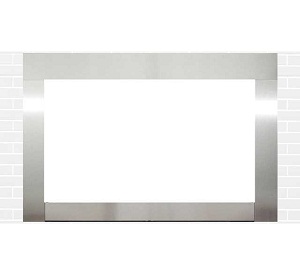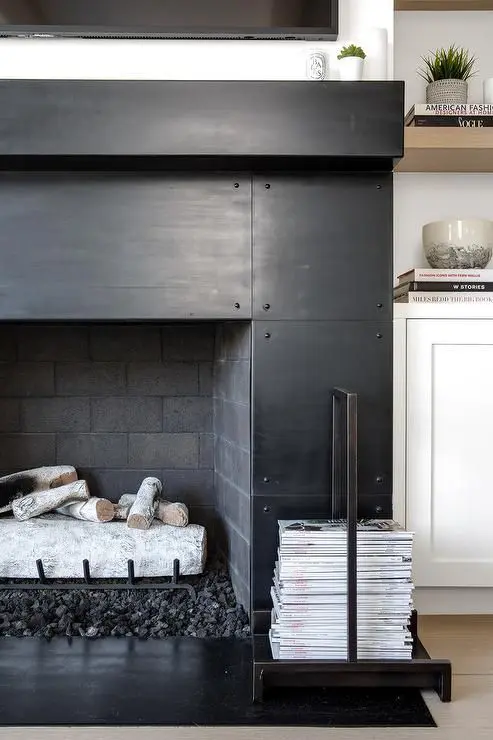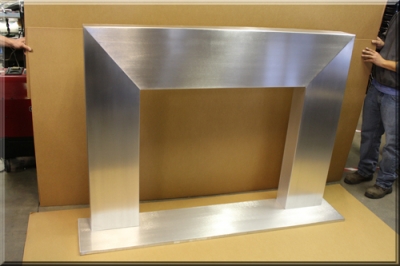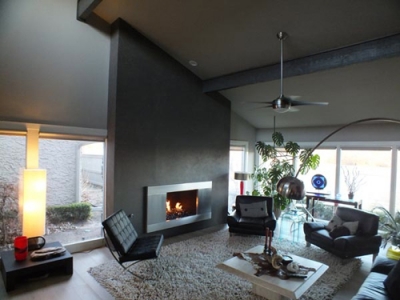A stainless steel fireplace surround has an unmistakably elegant appearance. It adds a contemporary touch to any living space while remaining durable and easy to maintain. When I chose to take on this project myself, I was drawn to stainless steel’s clean lines and reflective quality, which enhances both natural and artificial light. Whether you’re remodeling an old fireplace or building a new one, a DIY stainless steel surround is a simple job that yields gorgeous results. This is what I discovered along the road.
Why Use Stainless Steel for Your Fireplace Surround?
Stainless steel may not be the first material that springs to mind for a fireplace, but it offers several amazing benefits. Unlike wood or stone, it will not warp, crack, or discolor when exposed to heat. Its resilience to corrosion and staining makes it perfect for high-temperature environments, while its modern look complements minimalist, industrial, and even transitional decor styles.
I also enjoy how reflecting it is. A polished stainless steel surround bounces light throughout the room, making it appear brighter and more spacious. If you want a more modest look, brushed or matte coatings reduce glare while keeping a sleek, contemporary aesthetic. Furthermore, stainless steel is surprisingly easy to clean—a quick wipe with a microfiber cloth keeps it looking bright.
Another advantage is customisation. Unlike pre-made surrounds, a DIY approach allows you to customize the size, shape, and finish to your specific needs. Whether you want a full wall-to-wall installation or just a frame around the firebox, stainless steel may be cut and sculpted to your specifications.
Materials and Tools Required for the Project
Gather your necessities first. You’ll need stainless steel sheets (16- to 20-gauge works well), a metal-cutting tool (such as a circular saw with a carbide blade or an angle grinder), a drill with metal bits, screws or adhesive, a file for smoothing edges, and safety equipment (gloves, goggles, and ear protection). If you don’t feel comfortable cutting metal, several suppliers provide pre-cut panels to your specifications.
Consider how you’ll connect the components to achieve a seamless look. Welding produces the smoothest finish, but it requires skill and equipment. Simpler designs can also be achieved using hidden fasteners or high-temperature adhesive. I chose stainless steel screws with ornamental caps, which added a subtle industrial feature without requiring welding.
Don’t forget the finishing touches, such as edge trim or heat-resistant sealer. If your surround will be exposed to high temperatures, ensure that all materials are rated for such conditions. A little extra preparation guarantees that your project is both beautiful and secure.
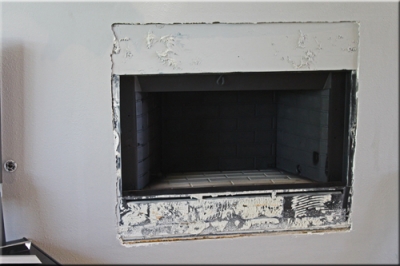
Step-by-Step Installation Procedure
First, carefully measure the size of your fireplace opening. Consider any gaps or imperfections in the wall when deciding whether your surround will be flat with the hearth or extend beyond it. Transfer these measurements to your stainless steel sheets and mark the cut lines with a grease pencil for visibility.
Cutting stainless steel demands patience. Go slowly to avoid bending the metal or causing sharp edges. After cutting, polish any rough parts using a file or sandpaper to prevent cuts during handling and provide a professional finish. Dry-fit the components before fixing them to ensure proper alignment.
Attach the surround using your preferred technique. To avoid metal distortion, pre-drill holes before screwing into studs or masonry. Apply adhesive evenly, and use clamps to keep components in place while curing. Finally, wipe down the entire surround to eliminate fingerprints and dust, revealing a stunning, polished finish.
Design Ideas For Your Stainless Steel Surround
A whole floor-to-ceiling stainless steel surround makes a bold statement, particularly in modern lofts or open-concept areas. Pair it with a linear gas fireplace for a futuristic design, or with a rustic wood mantel to combine industrial and farmhouse themes. A reflective surface can also make a small room appear larger.
For a more discreet approach, frame only the firebox with stainless steel. This is ideal for updating an existing brick or stone hearth. To counteract the metal’s coolness, add floating shelves made of a complementary material, such as walnut or black steel.
If you enjoy texture, try a brushed or patterned stainless steel finish. Geometric perforations or vertical grooves provide visual interest without overpowering the space. You may even illuminate the surround to create a subtle glow that highlights the metal’s shine.
How to Maintain Your Stainless Steel Fireplace Surround
One of the benefits of stainless steel is that it requires little maintenance. For daily cleaning, a microfiber cloth and warm water are generally plenty. If fingerprints or smudges are visible, a solution of water and mild dish soap works well—just avoid abrasive scrubbers, which may harm the surface.
A specialized stainless steel cleaner restores shine to harder stains or discolouration caused by heat. To ensure consistency, always wipe in the grain direction (visible as small lines on brushed finishes). If water marks emerge, a vinegar solution can help, but rinse well to avoid residue.
Minor scratches might occur over time, particularly on polished finishes. The majority can be rubbed out with non-gel toothpaste or stainless steel polishing paste. For severe damage, a professional refinishing may be required, but with good maintenance, your surround should look great for years.
Cost-Effective Alternatives and Tips
If actual stainless steel is out of your budget, consider stainless steel-look panels or laminate sheets. These look similar to the original but are less expensive and easy to cut and install. While not as durable, they are an excellent choice for renters or temporary improvements.
Another cost-cutting option is to utilize stainless steel tiles rather than sheets. They’re easier to use and can provide a stunning mosaic effect. To enhance dimension, combine them with a contrasting grout color. If the tiles will be in close proximity to flames, make sure they are rated for high heat.
Repurpose items like stainless steel appliance panels or salvaged industrial components to provide a genuinely one-of-a-kind touch. With a little creativity, you can create a one-of-a-kind surround that feels personalized without paying a premium.
Is stainless steel safe to use near a wood-burning fireplace?
Yes, but with caution. Stainless steel is heat resistant, however direct exposure to high temperatures can cause warping or discoloration. Maintain adequate distance between the firebox and the surround (check local codes, but 6-12 inches is normal). For wood-burning fires, a non-combustible backing, such as cement board, provides additional protection.
Can I add a stainless steel surround to an existing brick or tile fireplace?
Absolutely! Stainless steel can be placed directly over brick or tile using the appropriate adhesive or mechanical fasteners. Ensure that the surface is clean, dry, and flat. If the present surround has a high roughness, consider using a thin plywood underlayment to achieve a smoother finish.
How can I keep my stainless steel surround from looking too chilly or industrial?
Warm it up using textures and materials. Soften the look by pairing it with a wood mantel, leather furnishings, or woven textiles. Lighting also helps—warm-toned lighting or candles reflect nicely off the metal, creating a comfortable atmosphere.
Does a polished stainless steel surround show scratches easily?
Polished finishes reveal more scratches than brushed surfaces, but minor marks may usually be wiped off. If longevity is a concern, choose a brushed or matte finish, which hides defects while maintaining a modern appearance.
Can I make a stainless steel surround if I don’t have any metalworking experience?
Yes! Begin with a basic design, such as a flat panel frame, and use pre-cut metal to eliminate complicated cutting. Many home improvement stores provide metal cutting services for a modest cost. Watch online tutorials, take your time, and start with scrap pieces.
How do I secure the stainless steel surround without exposing the screws?
Hidden fasteners and high-temperature construction adhesive are excellent solutions. You can either solder the parts (if you have the abilities) or cover the screw heads with trim strips to achieve a seamless effect. Some do-it-yourselfers even utilize strong magnets for detachable panels.
Aluminum or Stainless Steel fireplace surrounds. Stainless steel
Stunning Interiors With Steel Fireplace Surround Focal Points
Aluminum or Stainless Steel fireplace surrounds. Stainless steel
How to Spray Paint a Brass Fireplace Insert – A Butterfly House
Related Posts:
- Fireplace Surround Ideas
- DIY Stainless Steel Fireplace Surround
- Modern Concrete Fireplace Surrounds
- Fibreglass Fireplace Surround
- Walnut Fireplace Surround
- Fireplace Surround Replacement
- Thin Brick Fireplace Surrounds
- Cherry Fireplace Surround
- Victorian Tiled Fireplace Surround
- Carved Marble Fireplace Surround
